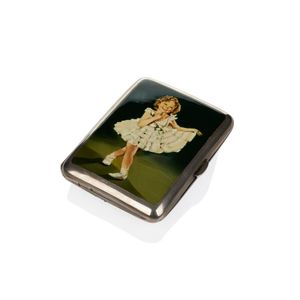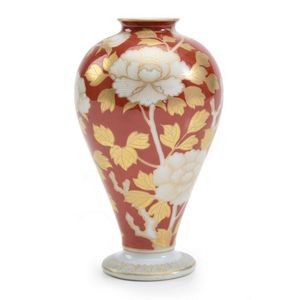Gilded Peonies Koransha Vase, Meiji Period
You must be a subscriber, and be logged in to view price and dealer details.
Subscribe Now to view actual auction price for this item
When you subscribe, you have the option of setting the currency in which to display prices to $Au, $US, $NZ or Stg.
- Gilding - Gilding is a method of ornamentation whereby a thin sheet of gold metal is applied to items made of wood, leather, ceramics, glass and silver for decorative purposes.
For furniture including mirrors, the sheet of gold is usually applied over a coating of gesso. Gesso is a mixture of plaster of Paris and gypsum mixed with water and then applied to the carved wooden frames of mirrors and picture frames as a base for applying the gold leaf. After numerous coats of gesso have been applied, allowed to dry and then sanded a coat of "bole", a usually red coloured mixture of clay and glue is brushed on and allowed to dry, after which the gold leaf is applied. Over time parts of the gilding will rub off so the base colour can be seen. In water gilding, this was generally a blue colour, while in oil gilding, the under layer was often yellow. In Victorian times, gilders frequently used red as a pigment beneath the gold leaf.
Metal was often gilded by a process known as fire gilding. Gold mixed with mercury was applied and heated, causing the mercury to evaporate, the long-term effect of which was to kill or disable the craftsman or woman from mercury poisoning. The pursuit of beauty has claimed many victims, not the least of which were the artists who made those pieces so highly sought after today. - Circa - A Latin term meaning 'about', often used in the antique trade to give an approximate date for the piece, usually considered to be five years on either side of the circa year. Thus, circa 1900 means the piece was made about 1900, probably between 1895 and 1905. The expression is sometimes abbreviated to c.1900.
This item has been included into following indexes:
- Japanese ceramics, factories and cities - Koransha wares 45
- Japanese ceramics, item types - other 2,525
-
Satsuma (Japan), item type
- other items 2,034
- vases 1,376
Visually similar items

A Comprehensive Va Vista Alegre Portugal porcelain dinner service, customised with Fairfax Motto, embellished with blue bands picked out with gilded stars, each with lion rampant armorial and 'Lucem Fer Fac' banner, a version of the Fairfax family motto 'O

Pair Victorian mahogany spoon back armchairs olive green velvet upholstery, circa 1860, matching Lot 7

Ships & Planes: 1924-88 collection in album, noted 1924 Wills 'Merchant Ships of the World' (50); 1930 Wills 'Speed' (50); 1932 Lambert & Butler 'A History of Aviation' (Green Front) (25); 1938 Players 'Aircraft of the Royal Air Force' (50). Mainly G/VG. (

Shirley temple silver and enamel cigarette case, the front with hand painted enamel panel depicting Shirley temple in white dress, the back chased in high relief with floral decoration, with gilded interior, hallmarked, height 8.2 cm width 6 cm, approx. We
